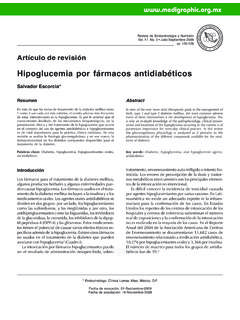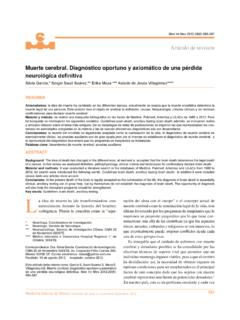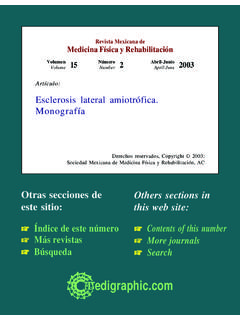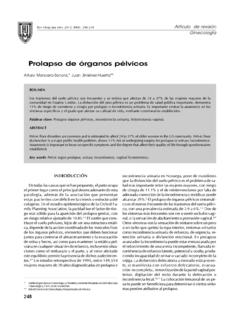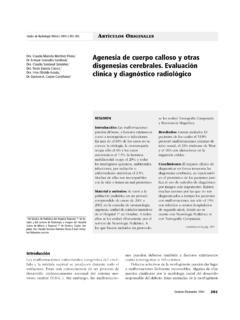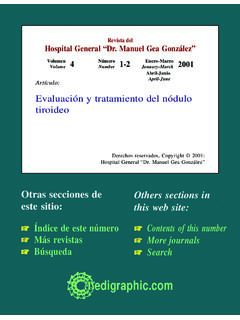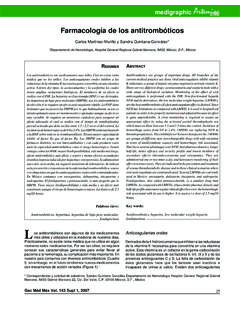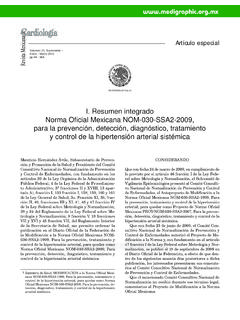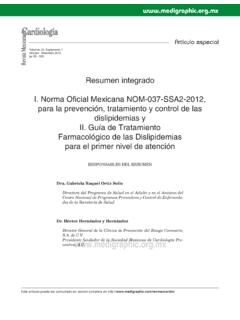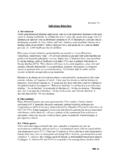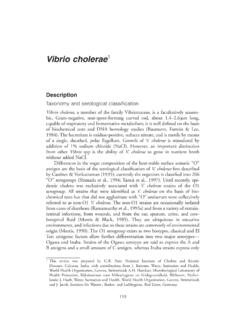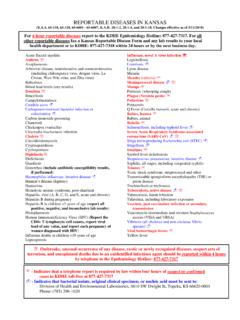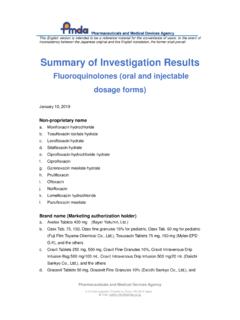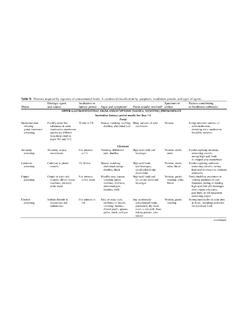Transcription of Pathogenic and non pathogenic Vibrio species in ...
1 Medigraphic Artemisa en l nea MICROBIOLOG A ORIGINAL ARTICLE. Revista Latinoamericana de Pathogenic and non Pathogenic Vibrio species in Vol. 49, Nos. 3-4. aquaculture shrimp ponds July - September. 2007. October - December. 2007. pp. 60 - 67 L. Noriega-Orozco,* E. Acedo-F lix,** I. Higuera-Ciapara,* R. Jim nez-Flores,** R. Cano**. ABSTRACT. Most shrimp farmers try to control Vibrio population RESUMEN. La mayor a de las granjas camaroneras controlan la pre- in their ponds regardless of their pathogenicity to human or shrimp sencia de bacterias del g nero Vibrio en sus estanques, sin considerar health. This study focuses on the biochemical diversity of Vibrio su patogenicidad al camar n o al humano. El presente estudio se enfo- species found in a typical semi-intensive shrimp pond in the Mexi- ca a determinar la diversidad bioqu mica de especies del g nero Vibrio , can Northwest and it correlates environmental conditions to patho- encontradas en estanques de cultivo semi-intensivo en el Noroeste de genic Vibrio species detected in pond water.
2 Bacterial diversity M xico y a correlacionar la presencia de especies pat genas a las con- changed with time, depending on water temperature. Such changes diciones ambientales de los estanques. A lo largo del ciclo productivo could be associated to dissolved oxygen, temperature and the pond se observaron cambios en la diversidad bacteriana de los estanques de itself. Growth conditions for Pathogenic highly salt-tolerant Vibrio camar n vinculados a la temperatura. Estos cambios fueron asociados species , are particularly favorable during the harvest period. Opera- tanto a la temperatura del agua en los estanques de camar n, como a tional Taxonomic Units (OTU) associated to Vibrio parahaemolyti- los niveles de ox geno disuelto y estanque analizado. En la etapa de cus or V. harveyi increased their population from 3 to 460 MPN ml cosecha, las condiciones en los estanques resultaron especialmente fa- -1at harvest time, while V.
3 Cholerae similar OTUs were only detect- vorables para el crecimiento de especies pat genas del g nero Vibrio ed at initial stages of the production cycle at extremely low levels. altamente tolerantes a la sal. Las unidades operacionales taxon micas (OTU) aisladas de las muestras, asociadas a las cepas control de Vibrio parahaemolyticus/V. harveyi incrementaron su poblaci n de 3 a 460. MPN ml -1 al momento de la cosecha, mientras que aquellas similares a V. cholerae fueron detectadas a muy bajos niveles, nicamente en las etapas iniciales del ciclo productivo. Key words: Vibrio , shrimp, aquaculture, water. Palabras clave: Vibrio , camar n, acuacultura, agua. INTRODUCTION they have been associated with skin infections and severe gastrointestinal disorders (Andrews, 2004, P rez- Vibrio spp occur naturally in aquatic environments Rosas and Hazen 1998, Venkateswaran et al 1998).
4 Some and are one of the most commonly-occurring bacteria of the Pathogenic Vibrio species have also been reported during shrimp farming (Vandenberghe, et al, 2003). The as the causal agents of shrimp infections (Goarant et al, number of reported Vibrio species has increased rapidly 1999). In contrast, other species such as Vibrio in the last decade. Thompson, et al (2004) have reported alginolyticus have been reported as probiotics for shrimp 63 environmental species comprising the genus Vibrio . aquaculture (Vandenberghe, 2003, Direkbusaram, et al, Ten of them are of human concern (Twedt, 1989) since 1998). Shrimp ponds are stressful environments compared to estuaries or other enclosed water bodies (Direkbusararam, et al, 1998). This is mainly due to high organic matter and * CIAD, Guaymas Research Station for Quality Assurance and Sustainable Utiliza- dissolved oxygen fluctuations which affect the composi- tion of natural bacterial communities.
5 Under normal con- tion of Natural Resources (CIAD-Unidad Guaymas). ditions, temperature increments will also bring about a ** CIAD, (Research Center for Food and Development) Hermosillo, Sonora M xico. greater diversity of Vibrio species (Barbieri, et al, 1999, ** CALPOLY, San Luis Obispo, California., USA. Pfeffer, et al, 2003). When high temperatures and high sa- First version received: May 22, 2007; first version revised: June 05, 2007 and August 20, linity conditions prevail, some species such as Vibrio 2007; second version received: October 31, 2007; second version revised: November 20, parahaemolyticus will predominate (Williams and 2007, December 22, 2007 and January 10, 2008; third version received: February 8, 2008; Ac- cepted: February 25, 2008. LaRock, 1985). Nowadays, shrimp farming has become an important economic activity in many developing countries (FAO/.)
6 Noriega-Orozco et al Pathogenic and non Pathogenic Vibrio species in aquaculture shrimp ponds 61. Rev Latinoam Microbiol 2007; 49 (3-4): 60-67. NACA/UNEP/WB/WWF. 2006). Recently, an increasing lected in the wet portion of the pond wall. All samples number of shrimp farms have raised concern about water were collected in sterile plastic containers and transported quality and shrimp health because of their economic im- to the laboratory in insulated boxes to maintain low tem- pact on farm operations. Most farmers now recognize the peratures (below 5 C). Samples were analyzed the same relevance of Vibrio species in shrimp ponds, and safety day they were collected by traditional culture methods. levels for viable heterotrophic bacteria (VHB) and Vibrio The remaining water samples were frozen for further analy- species are commonly used as environmental health indi- sis.
7 Shrimp farm management provided access to daily cators. Routine counts of those bacterial groups in water monitoring records of temperature and dissolved oxygen and shrimp hepatopancreas and hemolymph are common (two daily measures) and the historical feeding records to (L pez-Torres, 2001). The routine determination of Vibrio document antibiotic usage. species in farms is quite useful in terms of pond manage- Samples were analyzed based on the Bacteriological ment decisions and in some cases the use of antibiotics is Analytical Manual for the identification of Vibrio choler- based on those results. On the other hand, preventive mea- ae, Vibrio parahaemolyticus, Vibrio vulnificus and other sures often include the use of disinfectant and antimicro- Vibrio spp. (Elliot et al, 1992). Tenfold dilutions in alka- bial solutions which alter the dynamics of bacterial com- line peptone water (APW) were prepared in order to esti- munities and may induce antibiotic resistance mate the MPN of Pathogenic Vibrio species .
8 Partial (6-8. (Verschuere, et al, 2000). This is a worldwide problem and hr) and complete (18-24 hrs) incubation at 35-37 C was has been documented in several Mexican shrimp farms carried out before transferring to TCBS (thiosulfate-cit- (Thompson, et. al, 2004). rate-bile salts-sucrose, Difco) agar plates. All yellow, Numerous studies of seasonal variation of Pathogenic green, and blue green colonies were selected for biochem- Vibrio species in natural environments can be found in the ical characterization (0%, 3%, 6%, 8% and 10% NaCl scientific literature (Williams, and LaRock, 1985; Ven- growth, motility, indole production, lysine and ornithine kateswaran, et al, 1989; Barbieri, et al, 1999; Pfeffer, et al, decarboxilase, sucrose, glucose and fructose fermentation, 2003; Hosseini, et al, 2004). Other studies refer to isolated arginine dihydrolase, oxidase and gelatinase).
9 The follow- strains from marine aquaculture systems (Gomez-Gil, et al, ing CAIM (Collection of Aquatic Important Microorgan- 1998; Vandenberghe, et al, 2003; George, et al, 2005), but isms) strains were included in the analysis: CAIM320-V. there is a notable lack of information regarding changes of parahaemolyticus; CAIM512-V. harveyi; CAIM516-V. al- Vibrio species in aquaculture systems along the growout ginolyticus; CAIM593-V. fluvialis; CAIM 602-V. mimic- period. This information is critical from a food safety as us; and CAIM610-V. vulnificus. Also a V. cholerae non well as from an economic impact perspective. Therefore, O1 strain, provided by the Mexican Health Department the aim of this work was to study the variations of Vibrio was used. species throughout the growout production cycle in Additionally, DNA extracted and purified from water shrimp pond water and soil and its association with patho- samples was tested for V.
10 Cholerae and V. parahaemolyti- genic Vibrio species . cus toxins gene using PCR. DNA extraction was conduct- ed based in the Marmur Protocol (Johnson, 1991) and MATERIALS AND METHODS Barns et al (1994) with some modifications. Thawed samples were vigorously mixed to allow homogenization. Water and soil samples were collected during the gro- Triplicates of 100 ml were centrifuged (15 min @ 3,000g), wout period, from seeding to harvest, in a shrimp (Litope- and the residue was washed with 10 ml of TE (10 mM Tris, naeus vannamei) farm located in the coastal area of Her- 1 mM EDTA, pH ), and centrifuged under the same con- mosillo, Sonora, Mexico. Pond selection was performed ditions; re-suspended with 1 ml of buffer solution (500. on the basis of pond size and age, seeding time, initial lar- mM Tris HCl pH , 100 mM NaCl, 1 mM sodium citrate). vae density, water recharge, and history of antibiotic us- age.

